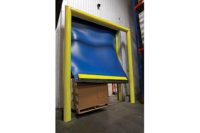When opportunity knocks, you open the door, especially if it’s an energy-efficient one. That’s because managing energy expenses is one of a refrigerated and frozen foods processor’s top conquests. Any chance to keep those energy costs down is an opportunity that can’t be missed.
Thankfully, many of today’s energy-efficient doors are designed with precision, efficiency and functionality in order to achieve energy management.
For instance, Pittsburgh-based TMI, LLC developed FlexTherm insulated curtain walls for climate-controlled applications. They separate cooler-to-cooler, cooler-to-freezer, freezer-to-freezer and cooler-to-ambient environments, are easily moveable and can give up to 27 degrees of temperature separation, according to Christopher Cummings, solutions sales manager.
“TMI’s range of flexible PVC strip doors and traffic doors is used on walk-in coolers and freezers as a secondary door, helping to comply with the Energy Independence and Security Act of 2007,” he adds. “They are also commonly found on large openings in cold storage warehouses and are especially helpful in managing different environments. They can handle forklift traffic, enhancing work flow and increasing visibility.”
Meanwhile, Rytec High Performance Doors, Jackson, Wis., designs doors to the next level with its series of high-speed insulated, high-speed fabric and high-speed washdown doors for food plants, coolers and freezers.
Rytec’s Clean-Roll door, for example, is a fabric roll-up door engineered specifically to meet USDA, FDA, NSF and ISO standards, says Kurt Angermeier, vice president of marketing. Meanwhile, the Turbo-Seal Insulated door is a roll-up door engineered to be fast, efficient and tight sealing.
“[It features] an extreme-duty electric motor, high-grade insulated panel and quad seals (two seals on each side of the panel) sealing the entire perimeter of the door opening,” Angermeier adds.
For cooler environments, especially those with chemical washdowns, Weiland Doors, Madison, Neb., manufactures “molded fiberglass and metal-clad doors that that combine high r-value insulation, high-speed operation and heavy-duty construction to withstand abuse in food production facilities,” says Rob Haake, director of sales and marketing. “High r-value doors, when combined with high-speed operators, make for a powerful combination of durability, corrosion protection, speed and lower total cost of ownership.”
Eliason Corp., Kalamazoo, Mich., also provides a series of doors for cooler applications.
“Eliason’s EISA door is a double-acting traffic door featuring gas-filled windows, a urethane foam core and a perimeter balloon gasket, which combines to earn it an R-value of 25,” says Rick Proskow, marketing manager. “It solves the problem of the cooler door being propped open during stocking, wasting valuable energy. The FCD-120 flexible door is made of single-ply vinyl on a top-mounted gravity hinge, allowing full access to a cooler. It is typically used as a secondary door on a cooler with a single-action main door. With no bottom hinge, pallet jacks and push carts can easily pass through, and the door will gently close behind them to block a majority of the cooled air from escaping while the main door is propped open. The FLT-400 flexible door is constructed of two layers of USDA-accepted, low-temperature belting material and is mounted on a top-mount gravity hinge for ease of passage of push carts and pallet jacks. Featuring jamb-edge balloon seals, wiper gaskets and frame-mounted top seals, this door stays flexible down to -30°F. It is well suited as a primary door in food processing frozen or cooler areas, or to separate a freezer and cooler area in one enclosure.”
Behind door No. 1 is… the future
The future for energy-efficient cold storage doors is on the upswing.
“More energy-efficient, larger, faster and cleaner doors with improved connectivity are the future of high-speed doors for refrigerated and frozen food processors,” says Angermeier. “With the preponderance of triple pallet jacks, ultra-high mast forklifts and ABC (activity-based compensation) labor, the door size and opening speed will continue to be important at large food plants and refrigerated warehouses.”
Plus, the future for cold storage doors involves the ability to combine durability, speed, high r-value and corrosion resistance at a compelling price without sacrificing quality, Haake says.
“Every door looks nice and shiny out of the box, but does it work well in the specific environment, and is it constructed to last two years or will it last 10 years plus?” he asks.
With a little bit of precision, efficiency and functionality, today’s energy-efficient doors may just last as long—if not longer—than the energy costs they’re saving.
HELPFUL HINTS WHEN SELECTING ENERGY-EFFICIENT COLD STORAGE DOORS
What are some things refrigerated and frozen food producers need to keep in mind when selecting and installing energy-efficient cold storage doors?
1. Understand the application. “While some doors may seem like a perfect solution, consult with your local cold storage or industrial door professional to review some of the intricate details that may make an impact on door performance, including negative air pressure, temperature, humidity, usage and return on investment,” says Christopher Cummings, solutions sales manager for TMI, LLC, Pittsburgh.
2. Comply with safety standards. “We’ve all heard the old adage that people don’t buy drills because they want drills; they want holes. In food plants, management teams don’t want doors; they want to comply with safety standards, maintain critical temperature deltas, increase the speed of traffic, save energy and save on maintenance costs. If they are engineered, installed and maintained correctly, ideally, the facility manager won’t even know the doors exist,” says Kurt Angermeier, vice president of marketing for Rytec High Performance Doors, Jackson, Wis.
3. Choose experienced installers. Even the best door in the industry won’t be satisfactory if installed incorrectly, says Rob Haake, director of sales and marketing for Weiland Doors, Madison, Neb. “And, even the most perfect installation can’t make the wrong door work well in certain environments. We recommend choosing experienced suppliers and installers who care about quality and service above all else.”
4. Consider total cost of ownership. For example, if a cooler is only accessed periodically, maybe a single-action door will suffice, says Rick Proskow, marketing manager for Eliason Corp., Kalamazoo, Mich. “However, if traffic is in and out more than a few times per day and/or the door is occasionally propped open, a double-acting door will save a significant amount of energy over the life of the cooler, while adding a great deal of convenience for those using the cooler,” he adds.







